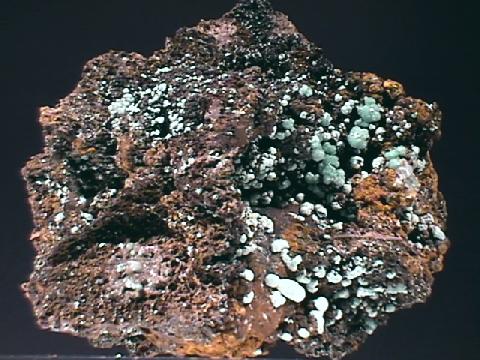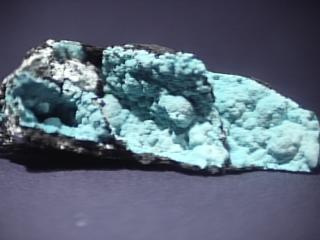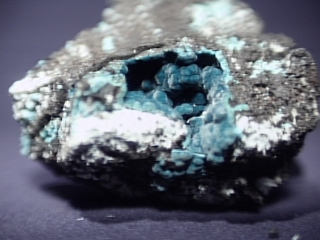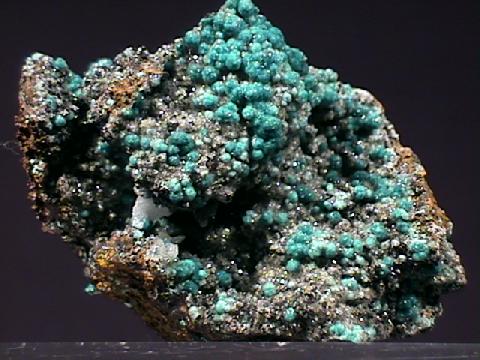
ROSASITE
Specimen ros-8
$ 30.00
Dims: 4.0 x 3.5 x 2.9" (10.2 x 8.9 x 7.4 cm)
Wt: 11.7 oz. (333 g)
Omega Mine, Helvetia District, Pima County, Arizona, U.S.A.
Scores of small Rosasite nodules rest on the goethite/limonite host rock of this specimen. These small orbs do not exceed 0.3" (8 mm) in diameter but are generally in very good condition, showing almost no human-induced damage. Most of these round formations are rather heavily worn and show no actual crystal form. However, there are a few clusters that are not worn, and show some indeterminate but visible monoclinic form. These "fresh" Rosasites have pearly luster and a deeper aqua-blue color than the weathered orbs, which are positively dull in luster. A few are covered with crusts of colorless, transparent calcite, but most are exposed. The red-brown host rock shows some definite botryoidal form in a few areas, but also appears weathered.
 Amethyst Galleries' Mineral Gallery MINERALS |

$ 90.00
Dims: 4.1" x 2.6" x 1.5"(10.4 x 6.6 x 3.8 cm)
Wt: 4.34 oz.(123.0 g)
Silver Bill Mine, Gleeson, Arizona, U.S.A.
This specimen contains a large amount of Rosasite, some of which is the most beautiful that I think I have seen. The specimen consists of thin layers of a dull, brown goethite/limonite host rock that have formed large hollows in a base of the same material. Most of the Rosasite consists of a pale blue botryoidal crust that coats the interior of these hollows. This crust has no crystalline form, a dull luster, and is opaque. Its color slightly deepens from the outer to the inner surfaces of the hollows. One of the smaller hollows actually forms a tunnel that goes through the specimen. The other opening is lined with the deepest blue-green Rosasite that I have ever seen. It also occurs in a botryoidal form, but it is easy to see from its luster that each nodule is made up of countless micro-thin acicular, radiating crystals. The formation has an almost velvet luster to it and is opaque. I suppose it is possible that the paler, crusty material is simply a weathered, worn version of this deep, plush formation. It really adds to the specimen!


Silver Bill Mine, Gleeson, Arizona, U.S.A.

ROSASITE specimen ros-3
$ 28.00
$ 28.00
Dims: 1.7" x 1.1" x 1.0"(10.4 x 2.8 x 2.5 cm)
Wt: 1.00 oz.(28.6 g)
Silver Hill Mine, Marana, Arizona, U.S.A.
This specimen consists of a crust formed by several round clusters of acicular, radiating Rosasite crystals, on a base rock made of various iron oxides. The crystals are extremely thin and fine, and do not exceed 0.1"(3 mm) in length. The clusters have a silky luster, and the crystals are translucent. A few small areas of the crust are coated with calcite, giving them a vitreous luster. A small amount of damage, in the form of bent or broken crystals, is visible, but the crust's general condition is very good. The host rock(likely composed of goethite) is red-brown to a deep-brown in color, has no luster, and exhibits botryoidal tendencies in some places.

ros-3 ($ 28.00)
Silver Hill Mine, Marana, Arizona, U.S.A.

ROSASITE specimen ros-4
$ 26.00
$ 26.00
Dims: 5.6" x 3.7" x 1.1" (14.2 x 9.4 x 2.8 cm)
Wt: 4.70 oz. (133.3 g)
Omega Mine, Arizona, U.S.A.
Hundreds of botryoidal globules of Rosasite rest on the host rock of this specimen, which appears to be slightly decayed, botryoidal goethite. The Rosasite has a very pale aqua-blue coloration and a dull luster, and is opaque. The formations are well-formed and are wonderful to look at under magnification. There are also several patches of both massive and clusters of bladed crystals of calcite scattered on the piece. One small area near a large formation of crystalline calcite shows tiny sprays of needlelike Rosasite crystals, which have a much deeper color than the botryoidal formations. The goethite host rock itself consists of two thin sheets that partially intersect each other and are coated with small botryoidal formations that are intergrown with the Rosasite. The narrow space between the sheets is filled with both calcite and Rosasite. It is one of the most attractive and interesting specimens that I have seen in months!


ros-4 ($ 26.00)
Omega Mine, Arizona, U.S.A.

ROSASITE specimen ros-5
$ 50.00
$ 50.00
Dims: 1.9" x 1.6" x 1.4" (4.8 x 4.1 x 3.6 cm)
Wt: 1.90 oz. (53.8 g)
Mina de Ojuela, Mapimi, Durango, Mexico
The decayed goethite host rock of this specimen is host to a beautiful crust of intergrown botryoidal Rosasite clusters. All are in excellent condition, showing almost no damage, and are quite small, not exceeding 0.2" (5 mm) in diameter. Each is made up of countless tiny, monoclinic needles of Rosasite that are tightly associated in acicular, radiating sprays. The crystals have a moderate aqua-blue coloration and are translucent. When clustered together, they give the crust a velvety luster. This crust covers at least 30% of the host rock's surface area. There is another crust of Rosasite coating part of the host rock, but this has a much paler coloration and lacks discernable crystals and botryoidal form. There are also several isolated botryoidal sprays elsewhere on the host rock, but these are tiny, and often damaged or incomplete.


ros-5 ($ 50.00)
Mina de Ojuela, Mapimi, Durango, Mexico

ROSASITE specimen ros-6
$ 45.00
$ 45.00
Dims: 2.9" x 2.7" x 1.3" (7.3 x 6.9 x 3.3 cm)
Wt: 3.07 oz. (87.2 g)
Omega Mine, Helvetia District, Pima County, Arizona, U.S.A.
Scores of tiny Rosasite sphericles rest on the classic limonite host rock of this specimen. The majority of these spheres rest on one side of the flat piece and are coated with a colorless and transparent layer of what is likely calcite, which forms a crust. The Rosasite spheres do not measure more than 2 mm in diameter and have a color that ranges from pale to deep aqua-blue. There are more of these spheres on the other side of the host rock, which shows some very interesting hollows in which the Rosasites rest. Most are intact and not covered by calcite, but a few are damaged and incomplete. High magnification is needed to see the fibrous, radiating habit of the Rosasite needles in these damaged spheres. There is a small amount of goethite present in the limonite matrix, along with what appear to be very fine intersecting veins of calcite, which likely induced the formation of the hollows.

ros-6 ($ 45.00)
Omega Mine, Helvetia District, Pima County, Arizona, U.S.A.

ROSASITE specimen ros-7
$ 30.00
$ 30.00
Dims: 2.2 x 1.6 x 1.3" (5.6 x 4.1 x 3.3 cm)
Wt: 1.6 oz. (44.8 g)
Omega Mine, Helvetia District, Pima County, Arizona, U.S.A.
Scores of tiny Rosasite nodules are scattered or clustered on the goethite and limonite host rock of this specimen. None of these nodules exceeds 0.1" (3 mm) in diameter, and most do not exceed 2 mm. They are generally in very good condition, though there are some that are noticeably damaged or incomplete. Their color is the standard deep aqua-blue and all have a rather dull waxy luster. There is a thin crust made up of tiny calcites beneath the Rosasites, which adds a little bit of a sparkle to the dull host rock in some areas.

ros-7 ($ 30.00)
Omega Mine, Helvetia District, Pima County, Arizona, U.S.A.

ROSASITE specimen ros-8
$ 30.00
$ 30.00
Dims: 4.0 x 3.5 x 2.9" (10.2 x 8.9 x 7.4 cm)
Wt: 11.7 oz. (333 g)
Omega Mine, Helvetia District, Pima County, Arizona, U.S.A.
Scores of small Rosasite nodules rest on the goethite/limonite host rock of this specimen. These small orbs do not exceed 0.3" (8 mm) in diameter but are generally in very good condition, showing almost no human-induced damage. Most of these round formations are rather heavily worn and show no actual crystal form. However, there are a few clusters that are not worn, and show some indeterminate but visible monoclinic form. These "fresh" Rosasites have pearly luster and a deeper aqua-blue color than the weathered orbs, which are positively dull in luster. A few are covered with crusts of colorless, transparent calcite, but most are exposed. The red-brown host rock shows some definite botryoidal form in a few areas, but also appears weathered.

ros-8 ($ 30.00)
Omega Mine, Helvetia District, Pima County, Arizona, U.S.A.

ROSASITE specimen ros-9
$ 20.00
$ 20.00
Dims: 1.3 x 1.2 x 1.1" (3.4 x 3.1 x 2.7 cm)
Wt: 1.31 oz. (37.2 g)
Los Lamentos, Chihuahua, Mexico
The goethite/limonite host rock of this thumbnail specimen holds a few crusts of fibrous, radiating Rosasite needles. These needles are in excellent condition and do not exceed 0.1" (3 mm) in length. They are arranged in round clusters which are intergrown to form the crusts, giving them a botryoidal appearance. Though they are too fine to study effectively with a loupe, they likely have excellent monoclinic form. All have the pale aqua-blue color of the mineral and a "fuzzy" appearance caused by the radial fibers.

ros-9 ($ 20.00)
Los Lamentos, Chihuahua, Mexico

ROSASITE specimen ros-10
$ 75.00
$ 75.00
Dims: 1.9 x 1.2 x 1.0" (4.7 x 3.0 x 2.5 cm)
Wt: 1.0 oz. (27 g)
Silver Bill Mine, Gleeson, Cochise County, Arizona, U.S.A.
This beautiful hand specimen consists of a limonite base rock that is covered with a thick layer of reniform and compact, radial Rosasite. This Rosasite crust shows moderate damage, where an intersecting crust apparently broke off. This damage appears to be partly healed, however, and helps one to see the radial nature of the mineral. Its color ranges from dark to bright aqua-blue, and its luster ranges from a dull silky on the reniform surfaces to a bright pearly on the damaged ones.


ros-10 ($ 75.00)
Silver Bill Mine, Gleeson, Cochise County, Arizona, U.S.A.

ROSASITE specimen ros-11
$ 25.00
$ 25.00
Dims:3.1x2.1x1.1" (7.9x5.3x2.8 cm)
Wt: 2.8oz. (79g)
Omega Mine, Helvetia District, Pima cty., Arizona
On this specimen, a thin crust of rosasite nodules rests on a matrix of limonite/goethite and malachite. These nodules have a pearly luster, but no crystal faces are evident.The only damage visible to the rosasite is on the edges of the crust.

ros-11 ($ 25.00)
Omega Mine, Helvetia District, Pima cty., Arizona

ROSASITE specimen ros-12
$ 32.00
$ 32.00
Dims: 3.35x2.09x1.30" (8.5x5.3x3.3cm)
Wt: OZ (G)
Mapimi, Chihuahua, Mexico
Clinging to the cavity walls of a piece of limonite lie dozens of teal-blue balls of rosasite. A loupe reveals that each ball is composed of hundreds of fine acicular crystals in a dense radial cluster. They lie on a crust of some black mineral which I have not identified. The color contrast on this specimen is pleasing.

ros-12 ($ 32.00)
Mapimi, Chihuahua, Mexico

ROSASITE specimen ros-13
$ 25.00
$ 25.00
Dims: 3.01x2.14x1.33" (7.65x5.45x3.37cm)
Wt: 4.08oz (115.8g)
Omega Mine, Helvetia District, Arizona, USA
A piece of limonite is host to hundreds of tiny turquoise colored balls of rosasite. A loupe reveals these as clusters of still tinier balls of rosasite. They are solid, and do not appear to be composed of acicular crystals. The bulk of the visible crystals on this specimen are transparent, and milky to colorless, as flat blades with a rounded face. They are intergrown like some barite or selenite clusters, but I believe that they are something else, such as calcite or hemimorphite in a form I haven't seen before (both of these are commonly associated with rosasite), or possibly they are hydrozincite, which is chemically quite close to rosasite in composition.


ros-13 ($ 25.00)
Omega Mine, Helvetia District, Arizona, USA